In celebration of Women’s History Month, the Southampton Arts Center and AIA Peconic have teamed up for a screening next Thursday of the documentary “City Dreamers,” with 30 minutes of networking opportunities starting at 5:30 p.m.
“City Dreamers,” a 2018 documentary by Joseph Hillel, explores the changing urban environment through the lives and work of four groundbreaking women architects. Phyllis Lambert, Blanche Lemco van Ginkel, Cornelia Hahn Oberlander, and Denise Scott Brown have each dedicated over 70 years to observing, thinking about, and shaping the transformations of our cities. It will be shown at 6.
Born in 1927, Ms. Lambert began her career as a sculptor while living in Paris. At the time, the Seagram Company, owned by her father, Samuel Bronfman, was planning a new headquarters on Park Avenue, with a design by Pereira and Luckman Architects. Ms. Lambert was adamantly opposed to the design, and in a 1954 letter to her father she convinced him to rethink it.
Tasked with finding an alternative, she recommended Mies van der Rohe, who was given the project and also became her mentor, supporting her wish to become an architect. She went on to a distinguished career marked by multiple honorary degrees and awards, including the Vincent Scully Prize and the Ada Louise Huxtable Prize.
Van Ginkel (1923-2022) was a British-born Canadian architect who worked mostly in Montreal and Toronto. She is known for her Modernist designs as well as for planning Expo 67 and leading the preservation of Old Montreal.
She was the first woman to head a faculty of architecture in Canada and to be elected a member of the Royal Canadian Academy of Arts. She was recognized for combining urban planning with a focus on modernist design. Her many awards include honorary doctorates, the Vienna Grand Prix, the Massey Medal for Architecture, and the Gold Medal of the Royal Architectural Institute of Canada.
Born in Germany, Oberlander (1921-2021), who was Jewish, fled to England with her mother and sister in 1938 and arrived in the United States a year later. She earned a B.A. from Smith College and, in 1947, secured a degree in landscape architecture from Harvard, where she was taught by Walter Gropius.
She and her husband moved to Vancouver in the 1950s, where she established a landscape architecture firm. “She was a landscape architect who studied housing, who studied cities,” the architecture critic Paul Goldberger wrote of Ms. Oberlander. “Her entire career has been a rebuke to those who might be so foolhardy as to think that the design of landscape is mainly a matter of selecting plants.”
Ms. Scott Brown was born in Zambia in 1931, moved to London in 1952, and in 1959 to Philadelphia, where she earned master’s degrees in urban planning and architecture at the University of Pennsylvania, where she was on the faculty.
A principal of her firm Venturi, Scott Brown and Associates in Philadelphia, along with her late husband, Robert Venturi, she is regarded as among the most influential architects of the 20th century. In 1972 she, Venturi, and Steven Izenour published “Learning From Las Vegas: The Forgotten Symbolism of Architectural Form,” a profoundly important book that rejected minimalism and the International Style and helped advance postmodern architecture.

Next Thursday’s screening will be followed at 7:30 by a panel discussion intended to offer insights into the film and its relevance to today’s architecture. The panelists are Andrea Lamberti, principal at Rafael Viñoly Architects; Lindsay Kunz, principal and director of the New York office of Olson Kundig; June Williamson, a professor and director of graduate architecture at C.C.N.Y., and Southampton Town Supervisor Maria Moore. Julie Hatfield, president of Wright and Company Construction in Bridgehampton, will moderate.
Another half-hour of networking will follow the panel. Tickets are $20, $15 for AIA and SAC members. The program is accredited for two AIA learning credits.




